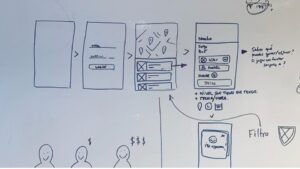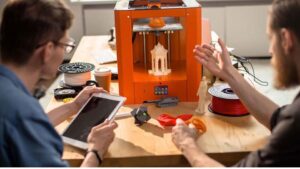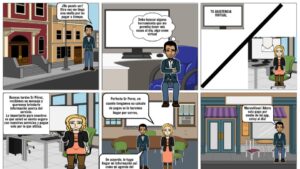EL PROTOTIPADO
Acelera tu empresa con estos consejos de expertos que cuenta sobre «El prototipado». ¡Analiza y descubre esta TIP!
El prototipado es el 4º paso del proceso de Design Thinking. Como otras herramientas el prototipado se utiliza para medir el grado de aceptación que un producto o servicio puede tener en el mercado y la intencionalidad de compra que despierta. Se utiliza, tanto en emprendimiento, durante el proceso de validación del producto, como en el proceso de desarrollo de nuevos productos. En él damos forma a esa gran idea emanada de la lluvia de ideas y de proponer un Producto Mínimo Viable.
El objetivo en esta fase no es crear un producto perfecto con todas las funcionalidades deseables. Se trata de crear un prototipo de bajo coste que nos permita testarlo en el mercado y probar su viabilidad (+). Prototipar ideas consiste en crear artefactos físicos que nos permitan tangibilizar de forma ágil una idea, para poder mostrarlos a los usuarios. Sin embargo, también los productos no tangibles, servicios, pueden ser prototipados mediante procedimiento gráficos.
Veamos algunos de las versiones de prototipado más utilizadas
Grafismos
DIBUJOS
Es una forma primaria de prototipado, no requiere de dotes artísticas y, permite explicar gráficamente el concepto. Los dibujos pueden ser utilizados para representar productos en su totalidad o partes de estos. También, se utilizan, para describir formas de uso.

Tangibilizaciones
MAQUETAS
Es una fórma sencilla que permite utilizar legos, palillos, plastilina. Se puede llegar incluso a la impresión en 3D que permite llegara un alto nivel de aproximación al producto final. obviamente se utiliza en el desarrollo de productos tangibles.

En el sector de alimentación se denomina maqueta a una muestra de laboratorio del producto a testar. Los aspectos que se miden son el color, olor y los valores organolépticos del producto. Se suelen preparar varias opciones con diversos niveles en los valores más importantes: cremosidad, dulzor, densidad, etc.
Narraciones
STORYBOARD (+)
Se trata de explicar el producto colocando en un contexto determinado. En esencia, se trata de un comic, que represente el producto o servicio, su funcionamiento y el contexto en el que se utiliza.

Y, si no te gusta dibujar, puedes utilizar storyboardthat.com. En la versión gratuita puedes utilizar hasta 6 viñetas. Puedes ampliar información en este enlace (ver +).
STORYTELLING (+)
Es un sistema que sirve para contar historias. Es un método potente para colocar en situación al interlocutor en relación a la solución que queremos plantearles. Las historias bien contadas generan atención y enamoran.

Dramatizaciones
ROLL PLAY
El prototipado puede hacerse con otras herramientas como el role play con el que podemos incluso reproducir una experiencia de compra en una tienda. Puedes recurrir a infografías que te permitan secuenciar procesos relacionados con la propuesta que estás realizando.

ESTOS ENLACES TE LLEVARÁN A LOS TIPS EN LOS QUE TRATAMOS LOS TRES PRIMEROS PASOS EN EL PROCESO DE DESIGN THINKING:
MAPA DE EMPATÍA (+).
DEFINICIÓN DEL PROBLEMA EN EL PROCESO DE DESIGN THINKING (+).
LA IDEACIÓN DENTRO DEL PROCESO DE DESIGN THINKING. IDEATE STAGE (+).
¿Qué es el prototipado?
El prototipado es una técnica que se utiliza en el proceso de validación de hipótesis en la creación de nuevas empresas. Consiste en la creación de una versión temprana del producto o servicio que se quiere ofrecer a los clientes, con el fin de probar su viabilidad y la validez de las hipótesis en las que se basa el modelo de negocio.
El prototipado puede ser de diferentes tipos, desde una maqueta o boceto hasta un prototipo funcional que pueda ser utilizado por los clientes. Los beneficios del prototipado son que permite a los emprendedores obtener una retroalimentación temprana y valiosa de los clientes, lo que les permite realizar ajustes y mejoras en su producto o servicio antes de su lanzamiento al mercado.
Además, el prototipado ayuda a los emprendedores a reducir los riesgos y los costos asociados a la creación de un nuevo producto o servicio, ya que permite descubrir y solucionar problemas en las etapas tempranas del proceso. También puede ser utilizado como una herramienta de marketing para generar interés y crear expectativas en los clientes potenciales.
En resumen, el prototipado es una técnica fundamental en la validación de hipótesis, ya que permite a los emprendedores obtener una retroalimentación temprana de los clientes, reducir riesgos y costos, y mejorar la calidad de su producto o servicio.
Consejos a un emprendedor para crear un prototipo de su solución
AQUÍ HAY ALGUNOS CONSEJOS PARA UN EMPRENDEDOR QUE DESEA CREAR UN PROTOTIPO DE SU SOLUCIÓN:
- Comience con el MVP: El prototipado se trata de crear una versión simplificada de su solución para validar sus hipótesis clave. Comience por crear un Producto Mínimo Viable (MVP) para tener una base sólida para su prototipo.
- Enfóquese en la experiencia del usuario: Asegúrese de que su prototipo se centre en la experiencia del usuario. Haga pruebas de usabilidad para identificar cualquier problema con el diseño y hacer mejoras.
- Use herramientas y recursos de bajo costo: Aproveche las herramientas de bajo costo, como los programas de diseño gráfico, para crear su prototipo. También puede usar herramientas de prototipado en línea para crear un modelo interactivo de su solución.
- Busque comentarios: Obtenga retroalimentación de su prototipo de sus amigos, familiares, colegas y otros emprendedores. Pregúnteles cómo se sienten acerca de su solución y cómo creen que se puede mejorar.
- Revise y mejore su prototipo: Utilice la retroalimentación que ha recibido para hacer mejoras en su prototipo. Si es necesario, vuelva a crear el prototipo para abordar cualquier problema importante.
- Realice pruebas en el mundo real: Una vez que tenga un prototipo sólido, realice pruebas en el mundo real para ver cómo funciona en el entorno real. Puede utilizar sus pruebas para validar aún más sus hipótesis y hacer mejoras adicionales.
- No tenga miedo de fracasar: El prototipado es un proceso iterativo. No tenga miedo de fallar y siga mejorando su solución.
APLICA ESTE TIP EN TU PROYECTO
TAREA
Ahora que ya has aprendido todo sobre esta TIP, deberías saber responder a estas preguntas:
- De todas las vías que hemos explicado para el prototipado. ¿Cuál es la que más se adecúa a a tu proyecto?
- ¿Podrías hacer un Storytelling de tu producto?
- Prepara un Roll play de la venta de tu producto.
CASO PRÁCTICO
María es una emprendedora que tiene una idea para crear una aplicación de ejercicio en línea. Su idea es ofrecer una plataforma de entrenamiento que permita a los usuarios personalizar su experiencia de ejercicio en función de sus objetivos y preferencias personales. Para desarrollar esta idea, María sabe que necesita hacer varios prototipos para probar diferentes características y obtener comentarios de los usuarios.
PARA ELLO, SIGUE LOS SIGUIENTES PASOS:
- Define el objetivo del prototipo: María quiere probar una nueva característica que permita a los usuarios crear rutinas de ejercicio personalizadas en función de sus objetivos y preferencias.
- Diseña el prototipo: María utiliza herramientas de diseño en línea para crear un prototipo visual de la nueva característica. Este prototipo incluye una pantalla en la que los usuarios pueden seleccionar el tipo de entrenamiento que desean hacer, los músculos que quieren trabajar, la duración de la sesión de entrenamiento y otros detalles.
- Crea un prototipo funcional: Para crear un prototipo funcional, María utiliza herramientas de codificación para crear una versión interactiva de la nueva característica. Esta versión incluye botones, menús desplegables y otras características interactivas que permiten a los usuarios crear sus propias rutinas de ejercicio.
- Prueba el prototipo: María invita a un grupo de usuarios a probar el nuevo prototipo y recopilar comentarios. Durante la prueba, los usuarios pueden probar la nueva característica y proporcionar comentarios sobre su facilidad de uso y efectividad.
- Itera el prototipo: A partir de los comentarios de los usuarios, María realiza cambios en el prototipo para mejorar su funcionalidad y facilidad de uso. Ella repite los pasos 3 y 4 varias veces hasta que está satisfecha con el resultado final.
Al utilizar el proceso de prototipado, María pudo probar su nueva característica antes de invertir tiempo y dinero en su desarrollo completo. Además, pudo obtener comentarios valiosos de los usuarios que le permitieron mejorar el diseño y la funcionalidad de la característica antes de su lanzamiento oficial.
QUIZ
- 💻 PRACTICA con un experto en el próximo webinar práctico.
- 🔎 CONSULTA más TIPs relacionadas con este mismo tema.
- 📖 AMPLIA tus conocimientos descargando este EBOOK.
PIENSA EN TI
- 🚀 IMPULSA tu empresa en el próximo programa de aceleración, ¡reserva tu plaza ya!.
- 🥁 PRACTICA con tu proyecto en este webinar práctico, ¡solicita tu plaza!.
- 🌐 CONTACTA con otros emprendedores y empresas, ¡inscríbete y participa en el próximo Networking!.
PIENSA EN AYUDAR A LOS DEMÁS
- 🤝COLABORA como voluntario: experto, mentor, inversor, premiando, difundiendo, retando, innovando, creando una TIP…
- 💬 RECOMIENDA este programa para que llegue a más emprendedores por Google.
- 👉 ¡COMPARTE tu aprendizaje!
- 📲 REENVÍA esta TIP 👇









